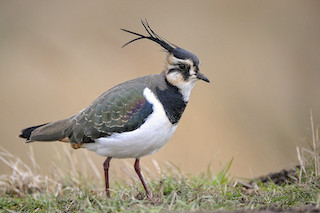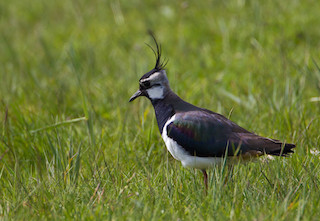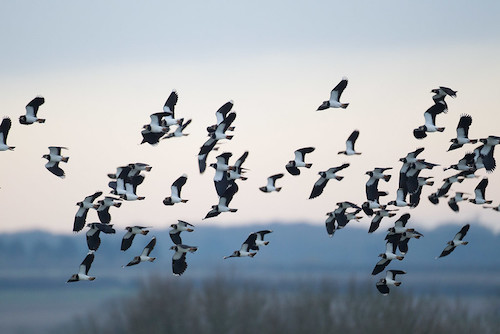 Numbers of resident Lapwings are increased by birds migrating from northern Europe in the winter. Watch out for them in pastures and wetlands.
Numbers of resident Lapwings are increased by birds migrating from northern Europe in the winter. Watch out for them in pastures and wetlands.
Photo: © Julian Dowse/Natural England
Scientific name: Vanellus vanellus
Other names: Northern Lapwing, Peewit, Green Plover, Flopwing, Old Maid, Teuchat.
Cornish name: Horneywink (dialect, not Cornish-language name)
Conservation status: Birds of Conservation Concern, Red List; and a bird of conservation concern in the UK Biodiversity Action Plan.
 The Lapwing’s common name refers to its irregular flying style, as does another of its common names, the rather droll Flopwing: the word ‘lap’ or ‘lapping’ is from the Old English word ‘hleapewince’, meaning to ‘leap with a flicker in it’. This bird of farmland, pasture and wetland is described in my 1986 bird field guide as ‘common throughout Britain and Ireland’. This could not be said with as much confidence now, just over 25 years later: like many farmland bird species, the resident breeding population of Lapwings has been declining significantly due to agricultural intensification and consequent loss of habitat, and the species is now Red-listed in the UK, although flocks of Lapwings remain a familiar sight.
The Lapwing’s common name refers to its irregular flying style, as does another of its common names, the rather droll Flopwing: the word ‘lap’ or ‘lapping’ is from the Old English word ‘hleapewince’, meaning to ‘leap with a flicker in it’. This bird of farmland, pasture and wetland is described in my 1986 bird field guide as ‘common throughout Britain and Ireland’. This could not be said with as much confidence now, just over 25 years later: like many farmland bird species, the resident breeding population of Lapwings has been declining significantly due to agricultural intensification and consequent loss of habitat, and the species is now Red-listed in the UK, although flocks of Lapwings remain a familiar sight.
There are about 130,000 breeding pairs of Lapwings in the UK. These numbers swell to over 600,000 individuals in the winter with the arrival of birds migrating from northern Europe, either to the UK or passing through on their way to southern Europe.
 Lapwings are as easy to recognise in flight as on land, with their black and white appearance, rounded, slow-beating wings, and a wingspan (up to c. 85 cm) that is large compared to their body length (around 30 cm). Most often heard during the breeding season in March to April, their ‘pee-wit’ calls are instantly recognisable. On terra firma, the most marked feature is the wispy crest, longer in males than females and juveniles, together with the glossy green/purple plumage of its back. You may also have seen a Lapwing in the spring pretending to have a broken wing in order to persuade predators away from its nest, a hollow in the ground.
Lapwings are as easy to recognise in flight as on land, with their black and white appearance, rounded, slow-beating wings, and a wingspan (up to c. 85 cm) that is large compared to their body length (around 30 cm). Most often heard during the breeding season in March to April, their ‘pee-wit’ calls are instantly recognisable. On terra firma, the most marked feature is the wispy crest, longer in males than females and juveniles, together with the glossy green/purple plumage of its back. You may also have seen a Lapwing in the spring pretending to have a broken wing in order to persuade predators away from its nest, a hollow in the ground.
Did you know…?
…The fairytale-like Spanish name for the Lapwing is ‘Ave frais’, meaning ‘the bird from the cold’, which refers to its migration south in the winter.
…Lapwings feed on their prey of invertebrates and worms mainly by night, in order to avoid competition from Black-headed Gulls thieving their food.
More information and references:
Gooders, J. and Harris, A., 1986. Field Guide to the Birds of Britain and Ireland. Kingfisher Books, London.

Published: November 2013
Author: Amanda Scott
Photos: Upper and of Lapwings in flight below: © Allan Drewitt/Natural England; middle: © Julian Dowse/Natural England
